文章信息
- 孟雅冰, 李新蓉
- MENG Yabing, LI Xinrong
- 两种集合繁殖体形态及间歇性萌发特性——以蒺藜和欧夏至草为例
- Morphology and intermittent germination characteristics of two types of synaptospermy: a case study of Tribulus terrester andMarrubium vulgare
- 生态学报, 2015, 35(23): 7785-7793
- Acta Ecologica Sinica, 2015, 35(23): 7785-7793
- http://dx.doi.org/10.5846/stxb201405090928
-
文章历史
- 收稿日期: 2014-05-09
- 网络出版日期: 2015-05-19
集合繁殖体又称为聚合传播体,是指两颗或多颗种子(或单种子果实)在萌发前聚合在一起形成一个联合传播体单元,依据其花器官的发生主要分为由一朵花联合心皮发育而成及由不同花发育组合而成的集合繁殖体[1, 2, 3]。它是植物对不稳定环境的一种独特适应方式,主要优势为:(1)保护及保水功能。大部分集合繁殖体的附属物是木质化、难以打开,保护种子免受机械损伤、抵御捕食者,能比单粒种子吸收更多的水分使其在合适的时机萌发,以保证物种的延续[4, 5]。(2)扩散对策。集合繁殖体具有多种扩散机制,在一定程度上为植物的拓殖及种子库的建立提供了丰富的手段,但其是否适应于远程扩散或抗远程扩散还存在不少争议[6, 7, 8]。(3)有效萌发对策。集合繁殖体在时空上将种子萌发分散在数年内,调节后代间的竞争力,这被称为间歇性萌发,这种“机会主义”萌发对策使种子逃避不利的环境条件,确保其在不可预期的降雨中长期延续[9, 10, 11, 12]。因此,集合繁殖体在研究植物的生态适应机制、生活史对策等方面具有重要意义。
目前国外关于集合繁殖体的报道主要集中于形态学[13, 14, 15, 16]、系统学[17, 18, 19, 20]及种子生态学[10, 20, 21, 22, 23]等方面,常见于石竹科[1, 2]、十字花科[1, 5]、罂粟科[18]、菊科[19, 20]、禾本科[1, 16, 21, 22]及葱科[24, 25]等植物类群,而国内只对荒漠环境下集合繁殖体的形态进行了初步比较[26, 27, 28]。不同生活型植物其繁殖体的作用不同,或侧重于种群生存和繁衍,或侧重于种群扩散。对不同生活型植物其集合繁殖体的形态特征和萌发行为特征未见系统报道。蒺藜(Tribulus terrestris)和欧夏至草(Marrubium vulgare)分别为一年生及多年生草本,其集合繁殖体发育分别起源于一朵花及多朵花。本文以这两种植物为材料,对其集合繁殖体形态及萌发特性进行初步研究,旨在探讨不同生活型植物其集合繁殖体的生态适应意义,为植物生活史对策等方面的研究提供重要的基础资料。
1 材料与方法 1.1 材料与方法蒺藜隶属蒺藜科蒺藜属,一年生草本,分果瓣5枚,较硬,果期6—9月;欧夏至草隶属唇形科欧夏至草属,单种属,多年生草本,花萼口具齿,果期7—9月[29, 30]。本实验在新疆乌鲁木齐市郊(43°56′ N,87°29′ E,平均海拔830 m)进行,该地区年降水量235.9 mm,蒸发量2731.0 mm,年平均气温8.6 ℃,年日照时数约2841.8 h,无霜期150—190 d[31]。
1.2 观测方法蒺藜扩散单位由分果瓣即集合繁殖体组成,其附属物不易与种子剥离,在本文中以集合繁殖体为观察单位,依照果实内发育成熟先后位置进行观察与实验。欧夏至草扩散单位分别为具附属物萼筒的集合繁殖体和无附属物的种子,集合繁殖体扩散前包裹4粒种子,将近轴端上部种子记为1,按顺时针方向依次标记进行萌发实验,在本文中以单萼筒的集合繁殖体与种子为观察单位进行比较。2012年9月采集成熟的蒺藜和欧夏至草扩散单位,翌年3月进行活力、吸水及萌发率的室内控制性实验。
1.2.1 集合繁殖体形态特征随机选取成熟且发育正常的蒺藜和欧夏至草扩散单位(n=100),记录颜色及形状,对其集合繁殖体分别进行附属物刺的长度测量,统计内部种子数,对蒺藜不同位置的集合繁殖体(n=100)及欧夏至草集合繁殖体(n=100)分别称重,后去除种子对附属物称重;测定欧夏至草种子千粒重;计算平均值。
附属物占质量百分比=附属物质量/集合繁殖体质量×100%
1.2.2 集合繁殖体活力特性蒺藜集合繁殖体(n=50)活力采用BTB法(溴代麝香草酚兰法)进行测定,蒸馏水浸泡24 h,次日掩埋于BTB溶液并在30℃烘箱持续加热4 h,集合繁殖体周围凝胶变黄色即该位置的种子具有活力,统计每个集合繁殖体变色的种子数,后纵切统计种子总数,计算平均值。
欧夏至草集合繁殖体(n=50)和种子(n=50)活力采用TTC法(氯化三苯基四氮唑法)进行测定,将集合繁殖体附属物去除,与无附属物的种子分别在蒸馏水中浸泡24 h,后将待测种子沿胚珠方向纵切置于新的培养皿中,加入0.1% TTC溶液,30 ℃恒温下浸泡6 h后清洗种子并计数被染红的数目,计算平均值。
1.2.3 集合繁殖体吸水特性25 ℃恒温条件下,对蒺藜集合繁殖体(n=50)依次称重后分别置于培养皿中进行吸水量测定,从放入培养皿起(第0小时)每隔1 h将其取出,放在滤纸上吸干表面水分,称重,再放回培养皿中,记录9 h内吸水量的变化值。欧夏至草集合繁殖体(n=50)和种子(n=200)吸水量的测定方法同上,但种子质量较小,因此其吸水量的测定选取每组200粒进行。
1.2.4 集合繁殖体萌发特性蒺藜和欧夏至草扩散单位(n=50)的萌发实验选取25 ℃恒温、光照/黑暗各12 h、水分5%的最适萌发条件下进行,以探索其萌发率及萌发规律性(实验均不考虑种子的休眠特性)。将其扩散单位分别置于直径为9 cm、铺有细沙的培养皿中,每天17:00—17:30称重以补充损失的水分,胚根突破种皮即萌发。记录每个扩散单位的萌发位置、萌发时间及持续时间,统计发芽数,2013年3月28日记录为第1天,持续观测60 d,观察结束时纵切统计每个集合繁殖体内种子总数;所用细沙采自生境沙漠,过1 mm孔径细筛,200 ℃,120 min下消毒。
萌发率=集合繁殖体内种子发芽粒数/集合繁殖体内种子总粒数×100%

式中,GR为萌发速率,Gt为第t天的种子发芽数,Dt为对应的发芽天数。
1.3 数据处理所有数据均用SPSS 19.0(SPSS公司)程序统计软件包进行处理和分析,采用One-way ANOVA及Two-way ANOVA比较不同数据组间的差异显著性,用Bivariate Correlation进行相关性分析。曲线图均用sigma plot 12.0绘图软件绘制。
2 结果与分析 2.1 集合繁殖体形态特征蒺藜扩散单位由5个分果瓣即5个集合繁殖体组成,成熟前不分离(图1,A);新鲜时呈鲜绿色,附属物坚硬,具短软毛或无毛,不易与种子剥离,其侧面有明显凸起的脊,充分发育时集合繁殖体各具一对长刺和一对短刺,刺尖多呈暗红色,最先成熟的长刺和短刺在果实中最长,分别为(4.0±0.7)mm和(2.6±0.7)mm(图1,D);集合繁殖体萌发前不开裂,萌发大多开始于最先成熟的集合繁殖体上,仅长刺端的种子在当季萌发,其腹缝线先裂开小口,胚芽穿过裂口生长(图1,E)。采集时依据集合繁殖体发育成熟先后位置进行标记,其质量、附属物占质量百分比及种子数依次减小,存在显著差异(表1)。

|
| 图 1 蒺藜和欧夏至草扩散单位 Fig.1 Morphology of dispersal units of Tribulus terrestris and Marrubium vulgare (A)蒺藜集合繁殖体扩散前依照发育成熟先后位置进行标记Marked synaptospermies of Tribulus terrestris come from single fruit in sequence of maturing before dispersal; (B)欧夏至草单萼筒集合繁殖体Single calyx tube of synaptospermy of Marrubium vulgare; (C)欧夏至草集合繁殖体内种子依照近轴端顺时针进行标记Marked the order of seeds by clockwise near axle of synaptospermy of Marrubium vulgare;; (D)蒺藜以集合繁殖体为扩散单位Synaptospermies compose the dispersal unit of Tribulus terrestris; (E)蒺藜集合繁殖体萌发特性Germination Characteristics of synaptospermies of Tribulus terrestris; (F)欧夏至草扩散单位Dispersal unit of Marrubium vulgare |
| (均值±标准偏差) | |||
| (mean ± SD) | |||
| 集合繁殖体Synaptospermy(n=100) | 质量/gMass | 附属物占质量百分比/%The percentage of appendage account for mass | 种子数/粒Number of seeds |
| 1—5为果实内按位置依次成熟的集合繁殖体;不同小写字母表示差异显著(P<0.05) | |||
| 1 | 0.0512±0.0094a | 61.78a | 3.1±0.3a |
| 2 | 0.0443±0.0110a | 62.64a | 2.8±0.4a |
| 3 | 0.0305±0.0115b | 61.54a | 2.1±0.7b |
| 4 | 0.0186±0.0086c | 49.63b | 1.3±0.8c |
| 5 | 0.0128±0.0083d | 24.93c | 0.5±0.8d |
| F | 104.961 | 22.070 | 110.358 |
| P | < 0.05 | < 0.05 | < 0.05 |
欧夏至草扩散单位由集合繁殖和种子组成,其中集合繁殖体以包裹种子的萼筒进行扩散,萼筒钟状,附属物占质量百分比约为45.29%,萼筒口密被绒毛,五枚长刺与五枚短刺交替呈现,较短较脆,平均分别为(2.4±0.2)mm和(1.2±0.3)mm(图1,B);集合繁殖体与种子质量存在极显著差异(P<0.01,F=446.877),扩散前其内含种子数(3.9±0.4)粒,种子成熟后为褐色,小坚果,卵状,其千粒重质量为(0.7321±0.01)g(图1,C);萼筒从植株上随机掉落,多以1个萼筒、8个萼筒、15个萼筒为集合繁殖体进行扩散(图1,F)。
2.2 集合繁殖体活力特性蒺藜集合繁殖体活力整体较高,依照其发育成熟先后位置依次降低,平均分别为96.03%、90.01%、86.67%、83.33%及82.50%,存在显著差异(P<0.05,F=102.437;图2);欧夏至草集合繁殖体和种子的活力分别约为72.42%和71.96%,不存在显著差异(P>0.05,F=28.597;图3)。
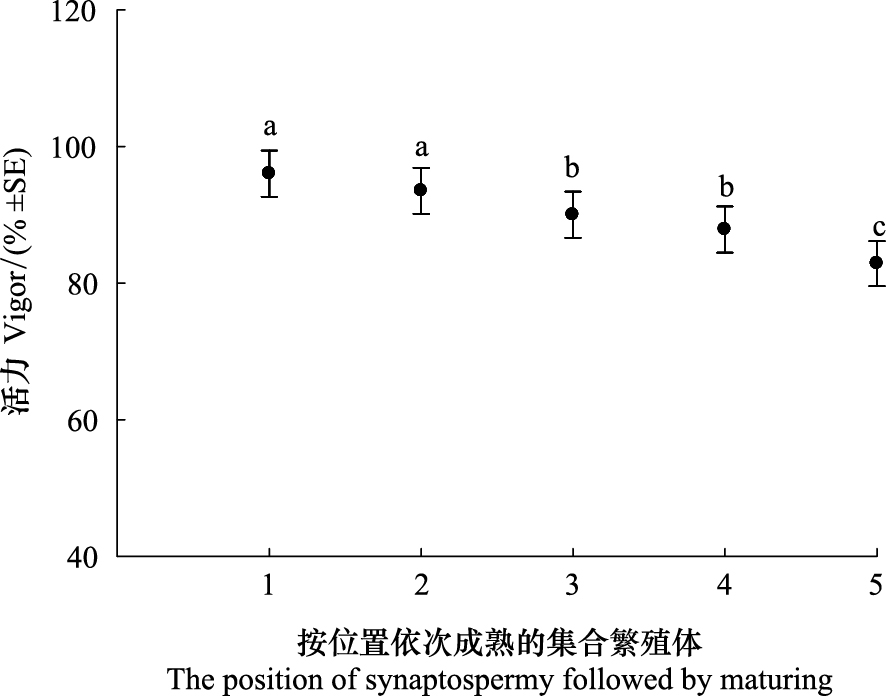
|
| 图 2 蒺藜集合繁殖体活力比较;1—5为果实内按位置依次成熟的集合繁殖体;不同小写字母表示差异显著(P<0.05) Fig.2 Comparison in vigor of synaptospermies of Tribulus terrestris; 1—5 indicate the position of synaptospermy by sequence of maturing per fruit; Different lowercase letters indicate significant differences (P<0.05) |
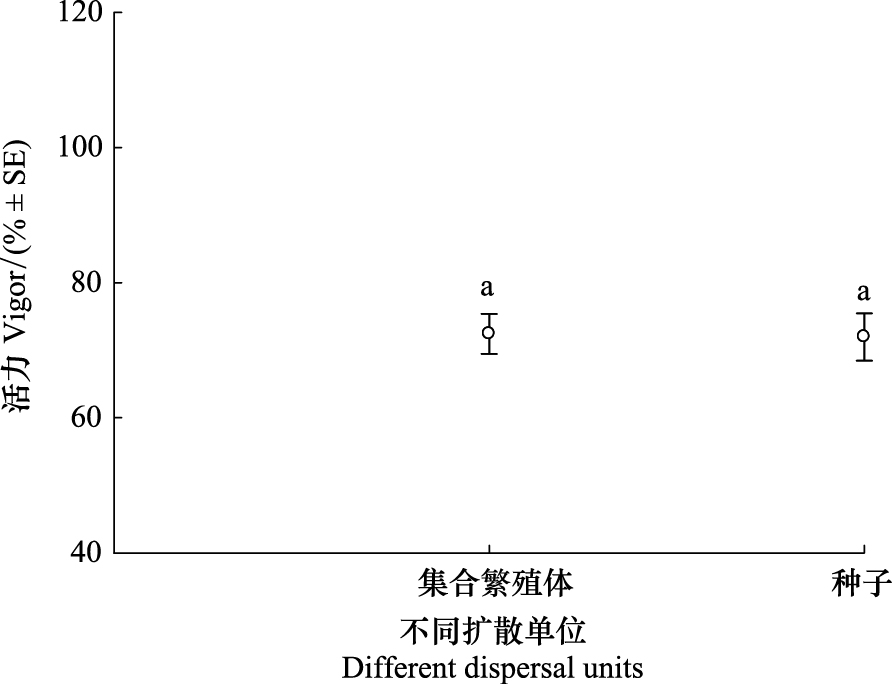
|
| 图 3 欧夏至草集合繁殖体与种子活力比较;小写字母表示差异不显著(P>0.05) Fig.3 Comparison in vigor of synaptospermy and seed of Marrubium vulgare; Lowercase letters indicate no significant differences (P>0.05) |
蒺藜和欧夏至草扩散单位基本在2 h内达到最大吸水量,吸水过程基本相似包括迅速吸水、缓慢吸水及停止吸水3个阶段。蒺藜最先成熟的集合繁殖体吸水量最大,最晚成熟的吸水量最少,分别为(0.0131±0.0118)g及(0.0053±0.0043)g,存在显著差异(P<0.05,F=104.583);集合繁殖体吸水量与质量呈极显著正相关关系(r=0.913,P<0.01,n = 50),质量越大,其吸水能力越强。欧夏至草集合繁殖体和种子最大吸水量分别为(0.0081±0.0002)g和(0.0039±0.0002)g,存在极显著差异(P<0.01,F=21.109),附属物的存在与否是影响种子吸水能力的重要因素(图4)。

|
| 图 4 蒺藜集合繁殖体与欧夏至草扩散单位吸水量 Fig.4 Water absorption of dispersal units of Tribulus terrestris and Marrubium vulgare 集合繁殖体1—集合繁殖体5为果实内按位置依次成熟的集合繁殖体;(A)蒺藜集合繁殖体间吸水量比较;(B)欧夏至草集合繁殖体和种子吸水量比较;不同小写字母表示差异显著(P<0.05) |
蒺藜集合繁殖体在当季只萌发1粒种子,萌发开始时间为第8—9天,在萌发第40天后未观察到同一集合繁殖体内第2粒种子萌发现象。果实内按位置依次成熟集合繁殖体萌发率平均分别为:58.89%、25.56%、17.78%、5.04%及4.32%,存在显著差异(P<0.05,F=64.202),虽都有萌发,但较晚成熟的萌发率较低(图5);果实内各集合繁殖体间萌发速率依次降低,存在显著差异(P<0.05,F=34.248;图7)。不同位置和成熟时间对萌发率双因素分析的结果表明:不同位置是影响萌发率的重要因素,存在极显著差异(P<0.01,F=35.952),成熟时间对萌发率作用显著(P<0.05,F=8.35),不同位置和成熟时间交互作用下对萌发率作用不显著(P>0.05,F=0.514),蒺藜集合繁殖体为非随机萌发。
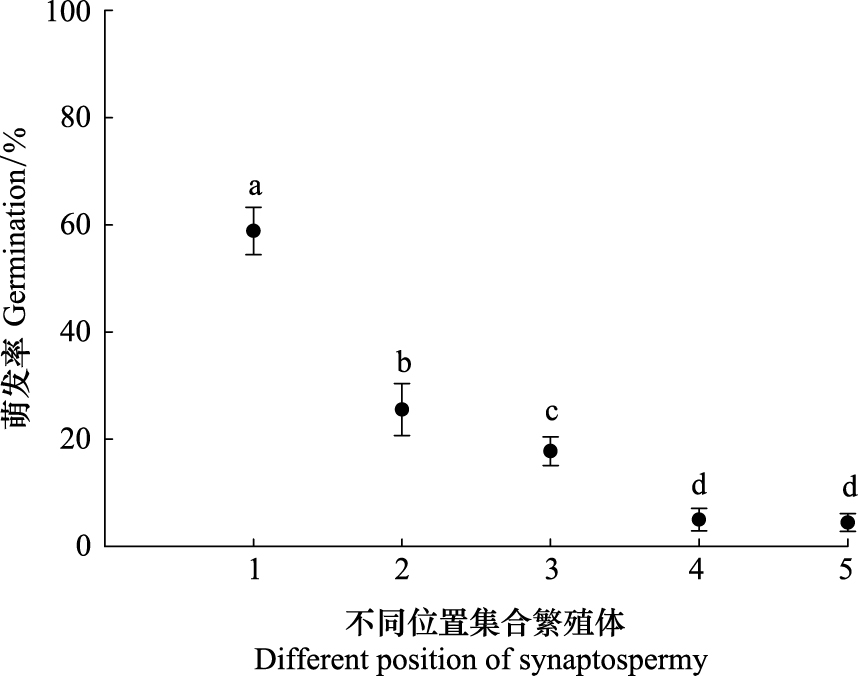
|
| 图 5 蒺藜集合繁殖体间萌发率比较 Fig.5 Comparison in germination of synaptospermies of Tribulus terrestris 1—5为果实内按位置依次成熟的集合繁殖体;不同小写字母表示差异显著(P<0.05) |
欧夏至草集合繁殖体的萌发位置随机分布,在当季最多只萌发一粒种子,不具有规律性,集合繁殖体和种子分别在第18—20天和第17—21天开始萌发,在第37天和第41天后停止萌发,萌发率较低,平均分别为15.16%和13.22%,不存在显著差异(P>0.05,F=12.574;图6);萌发速率基本相等,不存在显著差异(P>0.05,F=13.843;图7)。不同位置和成熟时间对集合繁殖体萌发率不存在显著差异,欧夏至草集合繁殖体为随机萌发。
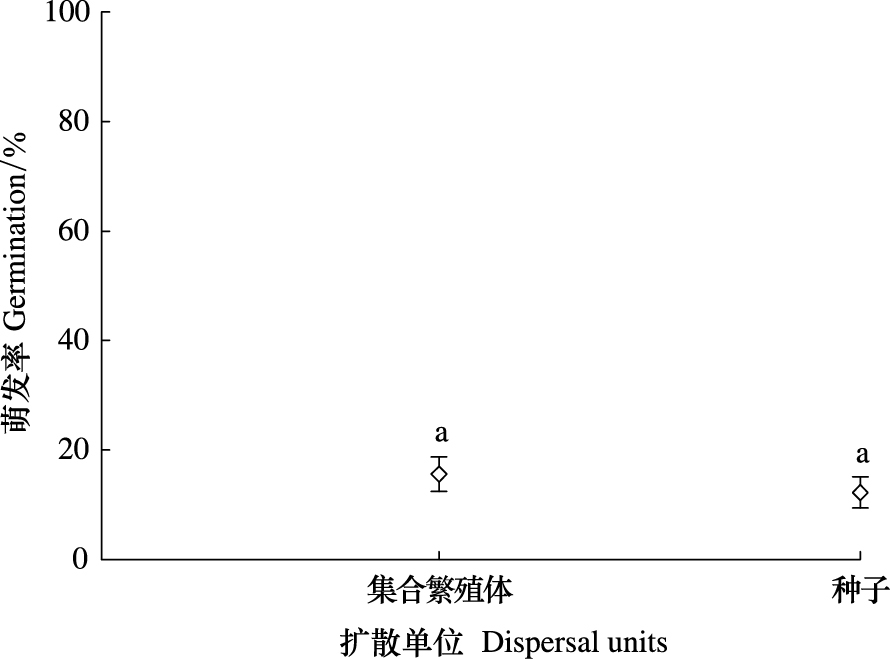
|
| 图 6 欧夏至草集合繁殖体和种子萌发率比较 Fig.6 Comparison in germination of synaptospermy and seed of Marrubium vulgare 小写字母表示差异不显著(P>0.05) |
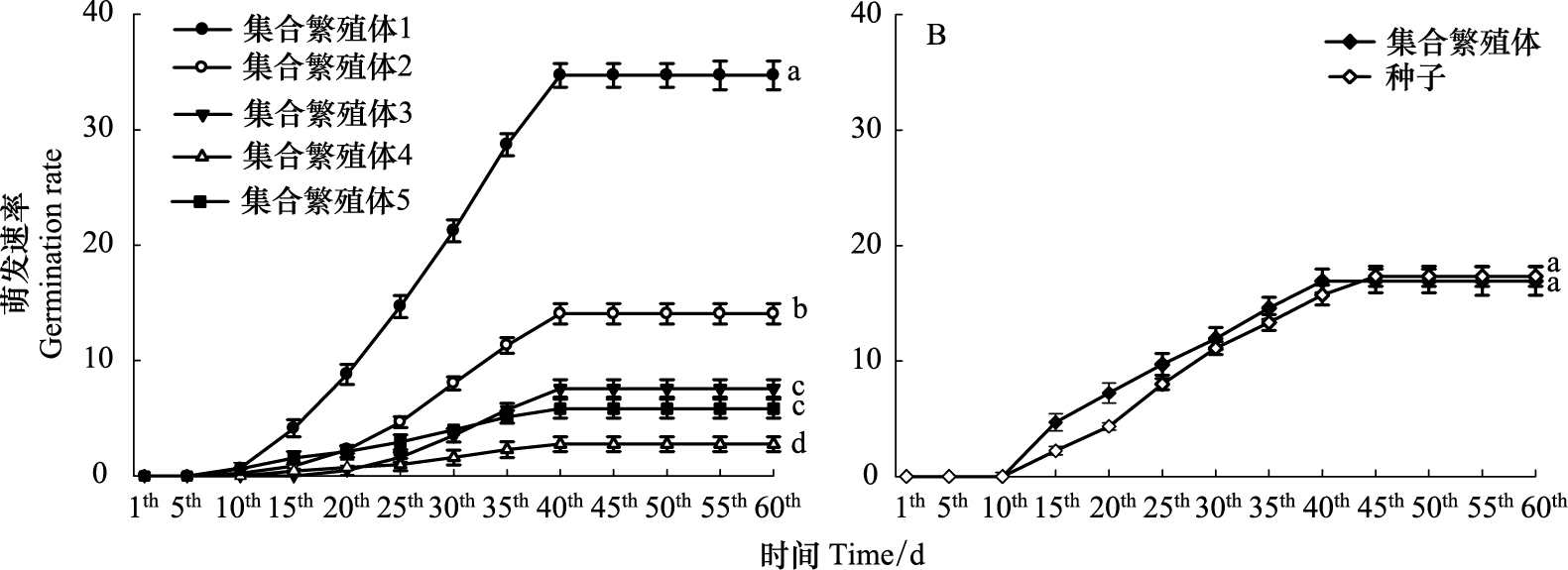
|
| 图 7 蒺藜和欧夏至草扩散单位萌发速率 Fig.7 Germination rate of dispersal units of Tribulus terrestris and Marrubium vulgare 集合繁殖体1—集合繁殖体5为果实内按位置依次成熟的集合繁殖体;(A)蒺藜集合繁殖体间萌发速率比较;(B)欧夏至草集合繁殖体和种子萌发速率比较;不同小写字母表示差异显著(P<0.05) |
本文中,蒺藜集合繁殖体依据其发育成熟先后位置在质量、附属物刺的长度、附属物占质量百分比、种子数、活力及吸水量等方面存在梯度变化;欧夏至草扩散单位具有多样性,集合繁殖体质量、吸水量等明显大于种子,但活力没有显著差异。虽然蒺藜和欧夏至草分别为一年生及多年生植物,但其附属物具有的功能相同:(1)保护作用。蒺藜和欧夏至草的附属物在干旱及不可预期的火烧和高温下对种子提供额外的保护作用,以抵御机械损伤或逃避捕食者。(2)保水作用。欧夏至草集合繁殖体能比无附属物保护的种子吸收更多的水分并更长期地保留水分,防止种子及所有重要萌发期的种子迅速干燥,其吸收的水分也可防止种子过早萌发。(3)扩散作用。蒺藜和欧夏至草集合繁殖体具附属物刺,一方面能够穿透动物的蹄或粘附在动物皮毛上进行远程扩散,另一方面动物蹄类的踩踏作用使得集合繁殖体被锚定在原有生境而适应了抗远程扩散。(4)萌发特性。集合繁殖体的附属物充当保护种子的容器,能建立随时间分散萌发的生理梯度,作为小型的动态种子库调节生长季内种子的萌发时机,保证其种群得以延续并对同胞种子间的竞争具有调节作用。蒺藜不具刺的附属物及欧夏至草多样的扩散单位,都可以扩散到距离母株更远的地方,这支持“Alternate”假说[5],即在空间上能有效地减少由近距离扩散带来的同胞子代间竞争,维持种群数量的稳定;而蒺藜和欧夏至草较大尺寸的集合繁殖体,不能轻易的被扩散媒介所运输,会持续保留在已占据有利地形的母株附近,这符合“mother-site”假说[5],即在时间上集合繁殖体必须演化出能降低后代竞争的策略,保证其种群得以延续。附属物特征对于集合繁殖体在荒漠环境中抵御干旱、逃避捕食,成功扩散、定居,保障物种延续并扩大种群等具有重要的生态学意义,它的形成是植物长期对荒漠环境适应过程中进化出的一种适应特征,它的存在决定了集合繁殖体活力及吸水率的差异,在时空上为萌发提供保障。
同一集合繁殖体内常伴随着萌发的多样性,影响着荒漠植物的生长及物种的延续,是对不确定性环境的重要适应机制。集合繁殖体附属物的功能,决定了其种子萌发的差异:(1)萌发位置。蒺藜集合繁殖体只在长刺端的种子观察到萌发,且同一集合繁殖体内当季只萌发一粒种子,属非随机萌发;而欧夏至草集合繁殖体萌发不具有规律性,属随机萌发,与Grielum humifusum,Aegilops geniculata及Mesembryanthemum nodiflorum等研究结果一致[2, 32]。(2)萌发时间。即使在最适萌发条件下,蒺藜和欧夏至草集合繁殖体在当季只萌发部分种子,剩下未萌发的种子分散在年内或年间,确保一定数量的幼苗为种群稳定打下坚实的基础,这种萌发机制符合间歇性萌发[33],与Pteranthus dichotomus及Buchloe dactyloides的结论相同[33, 34]。不同生活型植物的集合繁殖体,其间歇性萌发特性能有效避免种群覆灭,是一种风险分摊对策,如一年生草本植物繁殖体的形态特征和萌发行为特征对于种群繁衍非常重要,一方面种子库的部分种子可以有效萌发,供种群占领原有的生境,保持原有种群个体数量;另一方面,需要有一部分处于不同休眠深度或状态的种子陆续萌发有利其获得更多繁衍机会;而多年生草本植物,其繁殖体的形态特征和萌发行为对于种群的生存重要性相对低,多年生的母株可以长期占据原有的生境,保持种群个体数量,繁殖体的作用主要用于种群扩散。
种子的间歇性萌发可能与种皮渗透或胚的成熟度差异相关,或与种子的初级休眠、后熟以及次级休眠有一定的联系,而环境和遗传因素也是可能引起种子间歇性萌发的原因之一[10, 11, 12, 35]。关于间歇性萌发的机制还需补充更多类群和定量的实验数据。
| [1] | Zohary M. Plant Life of Palestine: Israel and Jordan. New York: The Ronald Press Company, 1962. |
| [2] | Van Rheede van Oudtshoorn K, van Rooyen M W. Dispersal Biology of Desert Plants. Berlin Heidelberg: Springer-Verlag, 1999. |
| [3] | Van der Pijl L. Principles of Dispersal in Higher Plants. 3rd ed. Berlin Heidelberg: Springer-Verlag, 1982. |
| [4] | Gutterman Y. Survival Strategies of Annual Desert Plants. Berlin Heidelberg: Springer-Verlag, 2002. |
| [5] | Ellner S, Shmida A. Why are adaptations for long-range seed dispersal rare in desert plants? Oecologia, 1981, 51(1): 133-144. |
| [6] | Howe H F, Smallwood J. Ecology of seed dispersal. Annual Review of Ecology and Systematics, 1982, 13: 201-228. |
| [7] | Kamenetsky R, Gutterman Y. Life cycles and delay of seed dispersal in some geophytes inhabiting the Negev Desert highlands of Israel. Journal of Arid Environments, 1994, 27(4): 337-345. |
| [8] | De Velliers A J, Van Rooyen M W, Theron G K. Seed bank classification of the Strandveld Succulent Karoo, South Africa. Seed Science Research, 2002, 12(1): 57-67. |
| [9] | Gutterman Y. Ibex diggings in the Negev Desert highlands of Israel as microhabitats for annual plants. Soil salinity, location and digging depth affecting variety and density of plant species. Journal of Arid Environments, 1997, 37(4): 665-681. |
| [10] | Cavers P B, Harper J L. Germination polymorphism in Rumex crispus and Rumex obtusifolius. Journal of Ecology, 1966, 54(2): 367-382. |
| [11] | Baker H G. The evolution of weeds. Annual Review of Ecology and Systematics, 1974, 5(1): 1-24. |
| [12] | Juby DV, Pheasant J H. On intermittent germination as illustrated by Helianthemum guttatum miller. Journal of Ecology, 1933, 21(2): 442-451. |
| [13] | Zohary M. Evolutionary trends in the fruiting head of Compositae. Evolution, 1950, 4(2): 103-109. |
| [14] | Stoutamire W. Chromosome races of Gaillardia pulchella (Asteraceae). Brittonia, 1977, 29: 297-309. |
| [15] | Navarro T, Oualidi J E, Taleb M S, Pascual V, Cabezudo B. Dispersal traits and dispersal patterns in an oro-Mediterranean thorn cushion plant formation of the eastern High Atlas, Morocco. Flora, 2009, 204: 658-672. |
| [16] | Hensen I. Life strategies of semi-desert plants: mechanisms of dispersal and reproduction in the thermomediterranean shrubland community anabasio-euzomodendretum bourgaeani. Anales del Jardín Botánico de Madrid, 1999, 57(1): 63-79. |
| [17] | Edmondson J. The correct name for the Prophet Flower: Arnebia Pulchra (Boraginaceae). Willdenowia, 1997, 8(1): 23-26. |
| [18] | Martin A. Seed germination and dispersal in Glaucium flavum Crantz (Papaveraceae). Acta Botanica Malacitana, 1996, 21: 71-78. |
| [19] | Katinas L, Crisci J V, Jabaily R S, Williams C, Walker J, Drew B, Bonifacino J M, Sytsma K J. Evolution of secondary heads in Nassuviinae (Asteraceae, Mutisieae). American Journal of Botany, 2008, 95(2): 229-240. |
| [20] | Katinas L, Crisci J V. Cladistic and biogeographic analyses of the genera Moscharia and Polyachyrus (Asteraceae, Mutisieae). Systematic Botany, 2000, 25(1): 33-46. |
| [21] | Quinn J A. Relationship between synaptospermy and dioecy in the life history strategies of Buchloe dactyloides (Gramineae). American Journal of Botany, 1987, 74(8): 1167-1172. |
| [22] | Quinn J A, Engel J L. Life-history strategies and sex ratios for a cultivar and a wild population of Buchloe dactyloides (Gramineae). American Journal of Botany, 1986, 73(6): 874-881. |
| [23] | Cheplick G P. Sibling competition in plants. Journal of Ecology, 1992, 80(3): 567-575. |
| [24] | Gutterman Y, Kamenetsky R, Van Rooyen M. A comparative study of seed germination of two Allium species from different habitats in the Negev Desert highlands. Journal of Arid Environments, 1995, 29(3): 305-315. |
| [25] | Kamenetsky R. Life cycle, flower initiation, and propagation of the desert geophyte Allium rothii. International Journal of Plant Sciences, 1994, 155(5): 597-605. |
| [26] | 刘志民, 蒋德明, 高红瑛, 常学礼. 植物生活史繁殖对策与干扰关系的研究. 应用生态学报, 2003, 14(3): 418-422. |
| [27] | 刘志民, 蒋德明, 阎巧玲, 李雪华, 李荣平, 骆永明, 王红梅. 科尔沁草原主要草地植物传播生物学简析. 草业学报, 2005, 14(6): 23-33. |
| [28] | 刘志民, 李雪华, 李荣平, 骆永明, 王红梅, 蒋德明, 南寅镐. 科尔沁沙地70种植物繁殖体形状比较研究. 草业学报, 2003, 12(5): 55-61. |
| [29] | 吴征镒. 中国植物志. 科学出版社, 1994. |
| [30] | 吴征镒. 中国植物志. 科学出版社, 2008. |
| [31] | 帕丽旦·萨力, 李新蓉. 天仙子的花部特征及延迟自交机制. 西北植物学报, 2012, 32(10): 2009-2015. |
| [32] | Van Rooyen M W, Theron G K, Grobbelaar N. Life form and dispersal spectra of the flora of Namaqualand, South Africa. Journal of Arid Environments, 1990, 19(2): 133-145. |
| [33] | Gutterman Y. Survival Strategies of Annual Desert Plants. Berlin Heidelberg: Springer-Verlag, 2002. |
| [34] | Gutterman Y. Environmental factors and survival strategies of annual plant species in the Negev Desert, Israel. Plant Species Biology, 2000, 15(2): 113-125. |
| [35] | Murdoch A J, Ellis R H. Dormancy, Viability and Longecity // Fenner M. Seed: The Ecology of Regeneration in Plant Communities. 2nd ed. Wallingford, UK: CABI, 2000. |
 2015, Vol. 35
2015, Vol. 35




